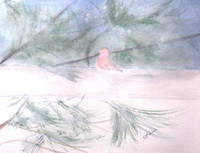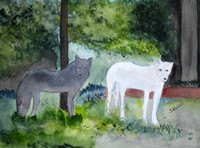

Briggs provides an extensive list of other names for the same phenomenon, though the place where they are observed (graveyard, bogs, etc.) influences the naming considerably. The Will o' the Wisp and the Snake by Hermann Hendrich (1854–1931)įolk belief attributes the phenomenon to fairies or elemental spirits, explicitly in the term " hobby lanterns" found in the 19th century Denham Tracts. Martin Luther's writings of the same 16th century.

Beside Irrlicht, the will-o'-the-wisp has also been called in German Irrwisch (where Wisch translates to "wisp"), as found in e.g.
WANDERING WILLOWS WALKTHROUGH ANIMAL QUARTZ FREE
Instead, the Latin ignis fatuus is documented no earlier than the 16th century in Germany, where it was coined by a German humanist, and appears to be a free translation of the long-existing German name Irrlicht ("wandering light") conceived of in German folklore as a mischievous spirit of nature the Latin translation was made to lend the German name intellectual credibility. The term is not attested in the Middle Ages either. Despite its Latin origins, the term ignis fatuus is not attested in antiquity, and what the ancient Romans called the will-o'-wisp may be unknown. The Latin name ignis fatuus is composed of ignis, meaning "fire" and fatuus, an adjective meaning "foolish", "silly" or "simple" it can thus be literally translated into English as "foolish fire" or more idiomatically as "giddy flame". In the United States, they are often called "spook-lights", "ghost-lights", or "orbs" by folklorists and paranormal enthusiasts.

The term jack-o'-lantern (Jack of the lantern) originally referred to a will-o'-the-wisp. The term "will-o'-the-wisp" comes from "wisp", a bundle of sticks or paper sometimes used as a torch and the name " Will", thus meaning "Will of the torch". Modern science explains the light aspect as natural phenomena such as bioluminescence or chemiluminescence, caused by the oxidation of phosphine (PH 3), diphosphane (P 2H 4) and methane (CH 4) produced by organic decay. In urban legends, folklore and superstition, wills-o'-the-wisp are typically attributed to ghosts, fairies or elemental spirits. Louis Light in Saskatchewan, the Spooklight in Southwestern Missouri and Northeastern Oklahoma, the Marfa lights of Texas, the Naga fireballs on the Mekong in Thailand, the Paulding Light in Upper Peninsula of Michigan and the Hessdalen light in Norway. Wills-o'-the-wisp appear in folk tales and traditional legends of numerous countries and cultures notable wills-o'-the-wisp include St. In literature, will-o'-the-wisp metaphorically refers to a hope or goal that leads one on, but is impossible to reach, or something one finds strange or sinister. The phenomenon is known in English folk belief, English folklore and much of European folklore by a variety of names, including jack-o'-lantern, friar's lantern, hinkypunk and hobby lantern and is said to mislead travellers by resembling a flickering lamp or lantern. In folklore, a will-o'-the-wisp, will-o'-wisp or ignis fatuus ( Latin for 'giddy flame', plural ignes fatui), is an atmospheric ghost light seen by travellers at night, especially over bogs, swamps or marshes. An 1882 oil painting of a will-o'-the-wisp by Arnold Böcklin.


 0 kommentar(er)
0 kommentar(er)
